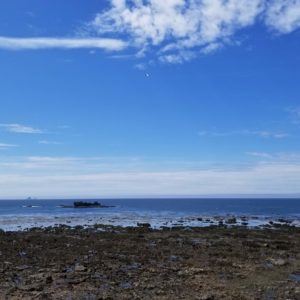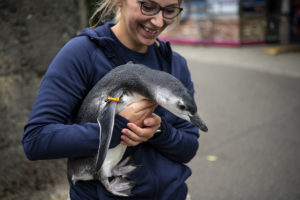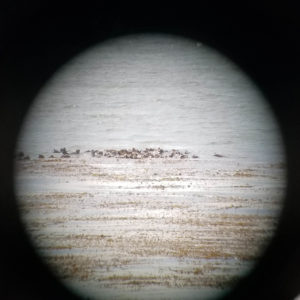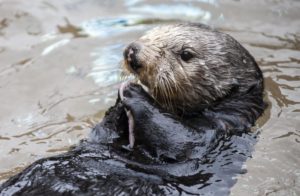
On a fine day this summer, Stephanie Rager, staff biologist at the Zoo’s Rocky Shores habitat, went for a hike. After three miles and a lot of uphill walking at the remote edge of Washington’s Olympic Peninsula, she arrived with two other women at the rocky outcrop of Sand Point. There they set up a scope, binoculars and a clipboard, and began to count otters.
It was the annual Washington Sea Otter Survey, and Rager – who spends her work days caring for the sea otters, sea lions and other marine animals at Point Defiance Zoo & Aquarium – was taking part for the very first time.
Otter Spotting
“It was so cool,” says Rager, who spent three days hiking to Sand Point with her count team.

“When we first arrived, my teammate – who had done this before – told me to look through the binoculars at a raft of otters and guess how many. I thought, maybe 80? 90? Then she said, ‘Now look through the scope.’ I did, and starting counting with my clicker – and I just kept clicking, up to 200. That was amazing. And we heard there’s even a bigger raft of 700 otters further out.”
Sea otter mothers and pups gather in groups, or “rafts,” just off shore, usually near kelp beds where they find their favorite food – purple sea urchins. Bachelor males hang out nearby.
But while it’s not something most of us do every day, seeing 200 otters off the Washington coast isn’t a rarity anymore. Hunted from the beginning of the fur trade in 1792, these adorable furry mammals (which range along the Pacific from northern Japan and Russia to Alaska and California) became extinct in Washington in 1910. They were reintroduced in 1969-70 with just 59 animals, and in 1989 the Washington Department of Fish and Wildlife began aerial and ground surveys to track their growth.
Rafts and Rafts

There are now around 2,000 Northern sea otters off Washington’s coast – an average growth of 9.5 percent every year. Zookeepers from Point Defiance Zoo’s Rocky Shores habitat have helped with the otter count for at least a decade. And it turns out that’s a good thing for everyone.
“Each day we would do three counts, including one that coincided with the count from the plane, for increased accuracy,” explains Rager, who took turns with her team members counting aloud through the powerful scope, checking for roving bachelors with binoculars and making detailed notes on a paper map. “Each count would last about 20 minutes. So in between, we would chat with passing hikers, who usually had no idea there were even otters out there. Because I’m familiar with them from my work, I could really engage them and educate them.”
Healthy otters, healthy oceans
Sea otters are vital to healthy oceans. By chomping down on urchins, they stop the spiky echinoderms from completely destroying kelp forests, which are essential habitats for many sea creatures and soak up much of the planet’s carbon dioxide.

Northern sea otters are protected from hunting and harassment by the federal Marine Mammal Protection Act and are listed as threatenedunder the Washington State Endangered Species Act. Their greatest threat is oil, which if spilled in their waterways can clog their dense fur. The otters then have no insulation against cold water temperatures, and ingest the oil as they try to groom. Moea, one of Point Defiance Zoo’s three otters, was rescued from just such an oil spill further down the coast.
For Rager, helping with the otter count was a highlight of her summer.
“It’s really awesome to be part of such a successful reintroduction of a species,” she says. “It’s so fun to watch them foraging and diving. We stayed in the town of Sekiu, which one of our otters is named after. And I saw some gray whales, as well. Most of all, though, this survey made me appreciate our zoo otters even more. They have such a cool connection to wild otters, and we talk about that connection all the time with our guests – how to protect wild otters by reducing pollution. To see otters in the wild and know that what I do every day is helping them just brought everything full circle.”
LEARN MORE: The annual Washington sea otter survey is organized and run by the U.S. Fish and Wildlife Service, with support from the Washington Department of Fish and Wildlife, Point Defiance Zoo & Aquarium, Seattle Aquarium and the Quinault Indian Nation. Learn more here.
PROTECT WILD OTTERS: You can help wild sea otters by reducing your car and yard pollution, choosing sustainable seafood and reducing your plastic use. Find out more on our otter page.
MEET OUR OTTERS: Meet our otters Libby, Moea and Sekiu every day at Rocky Shores, and meet their keepers at the 3pm marine mammal keeper chat.